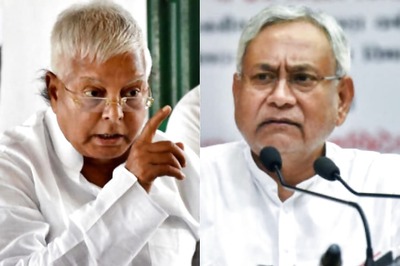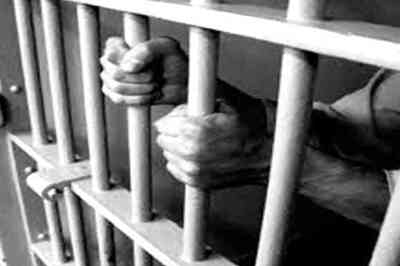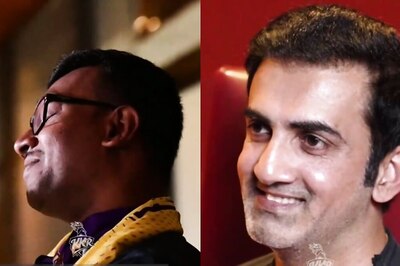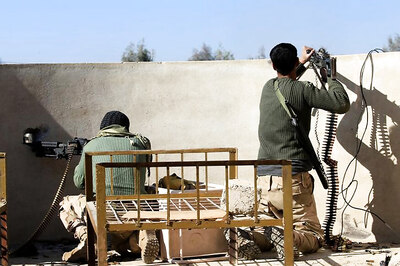
views
The wound of the Ram Janmasthan mandir is a long festering one for Hindus. While there are innumerable evidences, both literary and archaeological, of the presence of a temple below the so-called Babri masjid, the Left and Islamist “historians” have always hotly contested this fact, claiming that the existence and demolition of any such temple on the site prior to the building of the mosque is a complete myth.
As the day for ‘Pran Pratishtha’ nears, giving shape to the dreams of millions of Hindus in India and worldwide, this article will take a brief look back at the debate of the Ram Janmasthan issue, and various evidences that were presented by experts like Harsh Narain, Abhas Chatterjee, BB Lal, Sita Ram Goel, Arun Shourie, etc. that proved the existence of a temple prior to the building of the mosque and clinched the case for the Hindus. That an 11th century CE temple was present at the site, before it was partly demolished and converted into a mosque, was a historically known fact acknowledged by all, before the post 1947 left-Islamists belonging to the JNU roll-call of “historians” turned it into a myth.
Before we go into the debate and evidences, it is necessary to look into the Muslim claim that Shariah does not allow the building of mosques on land illegally grabbed or acquired, using which it was claimed by the JNU coterie that it was impossible to have a temple below the Babri masjid. Muslim intellectuals (eg: Sayyid Shahabuddin Abdur Rahman, a historian) show to the non-Muslims a verdict of Shariah that as per theological-juristic rulings no mosque can be built on land grabbed or illegitimately acquired (check Fatawa-i Alamgiri, Vol. 16, p.214). The ground reality is however different, and the foot soldiers of Islam take a completely opposite path, following a Hadith verse on the same issue.
A closer analysis reveals that the Shariah verdict given above stands nullified for land acquired in Jihad, because the Prophet had clearly stated that all land belongs to God or the Prophet, and through the Prophet, to all Muslims (Bukhari, II, Kitab al-Jihad wa’s-Sivar, Hadith 406). Iqbal puts this beautifully in a Persian verse: “Har mulk mulk-i mã’st ki mulk-i Khuda-i mast.” Translated it means: “all land belongs to the Muslims, because it belongs to their God.” Thus, jihad gives back to the Muslims what is rightfully theirs, and with this Hadith ruling, the Muslims feel they have the moral right to take away any land in jihad from non-Muslims. Thus, destroying a Hindu temple and building a mosque in its place is a possible act under the Hadith ruling, and has been taking place in India right from the start of Islamic invasions.
The following are the three core debates centring around the issue of a Hindu temple below the so called Babri masjid:
Ram and Ayodhya are fictional
Regarding Valmiki’s Ramayana, the left-Islamists at that time had claimed that “Since this is a poem and much of it could have been fictional, including characters and places, historians cannot accept the personalities, the events or locations as historically authentic unless there is other supporting evidence regarded as more reliable by historians” (refer A.R. Khan’s article “In name of History,” Indian Express, 25th February, 1990). Thus, attempts were made to cast aspersions on Ayodhya’s association with Ram and turn it into a mythical thing. Doubts were also expressed about Ayodhya’s location by the river Sarayu, and claims were made that Ayodhya was supposedly a city by the river Ganga, with evidences cited from few random texts.
The JNU nexus furthermore said that Ayodhya was previously known as Saketa and was an important centre of Jainism and Buddhism, and Ayodhya’s fame as centre of Ram’s worship was only of recent origin, apparently starting from around 13th century with the rise of the Ramanandi sect. These claims were made despite the 7th century Chinese traveller Hsuan Tsang clearly stating in his travel records about existence of Hindu shrines in Ayodhya. The name Saketa was changed to Ayodhya by Skanda Gupta in late 5th century, to draw on the tradition of the Suryavanshi kings, a lineage to which Ram belonged. Thus, 1600 years back, a Gupta king renaming a town as Ayodhya, hoping to gain popularity, only shows the importance of Ayodhya’s association with Ram, and the strong belief already entrenched in the minds of the common people about this association, as early as 5th century CE.
Temple never existed
The JNU “historians,” self-declared “secular scholars,” and politicians (Romila Thapar, Sarvepalli Gopal, Bipan Chandra, Harbans Mukhia, etc) at that time came up with the theory that existence and demolition of a temple at the janmasthan site was a myth/lie floated by the British in the 19th century following their ‘divide and rule’ policy. Syed Shahabuddin and many other maulvis further added that Babar would never demolish a temple to build a mosque, as that would go against Shariah verdict, and would be demolished by the Muslims themselves. However, this was a blatant lie, and many independent Muslim sources clearly showed that the masjid had indeed been built over a destroyed temple.
One such source was a letter of application filed by Muhammad Ashgar on November 30, 1858, where the applicant requested to file legal proceedings against Bairagiyan-i janmasthan. Here the masjid was referred to as masjid-i janmasthan and the courtyard around it as maqam janmasthan ka. The letter also mentions that Hindus have been performing worship at this place for hundreds of years (refer: Harsh Narain’s article, “Ram Janmabhoomi Temple: Muslim Testimony,” Indian Express, 26 January 1990).
Now taking into context the inscription in the mosque that says Mir Baqi built the mosque in 1528 under Babar’s orders, along with this letter of application that mentions masjid-i janmasthan, it is quite clear that there was some earlier Hindu religious structure that was destroyed and converted into a mosque by Mir Baqi, and it was for that reason the Hindus clung on to it and offered worship for hundreds of years.
That the Hindus continued worshipping at the site even after the destruction has been documented by many foreign travellers, prior to the “19th century British creating Hindu-Muslim divide” theory as floated by the Marxist “historians”.
In early 17th century, William Finch (1608-1611), an English traveller, wrote of Hindu presence at the site, while talking of Ramkot (Babri masjid-Ram mandir is within Ramkot), and described acts of worship and other religious rituals performed by the Hindus at the site. In mid-18th century an Austrian Jesuit priest Joseph Tieffenthaler, travelled Awadh between 1766 to 1771. In his travel diaries he described the presence of a vedi (crib for a newborn, referring to Vishnu born as Ram), 14 black carved temple pillars inside the mosque, Ramkot that was destroyed by Aurangzeb, and the destruction of a temple inside the premises of Ramkot over which was built a “Mohammedan temple with three domes.” Tieffenthaler further wrote that on the 24th of the month of Chait a gathering of the Hindus take place to celebrate the birthday of Ram, and this is famous across India.
In 1828, Walter Hamilton in his Gazetteer wrote about the large number of pilgrims who come to the site, and mendicants who walk around the various adjoining temples, bathe in holy waters, and perform various rituals at the site, which Hamilton described as the capital of the Great Ram.
Interestingly the 14 Hindu temple pillars inside the Babri masjid, seen by Tieffenthaler in the 17th century, on a closer inspection have revealed carvings at the base showing purna kalashas, held by four yakshas with overhanging creepers from which decorative lotuses rise up. On the octagonal sides of some of the pillars are carved apsaras/surasundaris standing in tribhanga pose, some of them being badly mutilated. During later excavations many more sculptures were found, which placed the site as being a Hindu temple originally.
The presence of a Janmasthan temple at Ramkot is found mentioned in the Sanskrit text Ayodhya Mahatmya, which is a part of Skanda Purana, and composed well before Babar’s invasion. It praises the sacredness of the site, terming it as the among the most sacred spots in Ayodhya, and gives the benefits of worshipping at the holy site especially on Ramnavami day. The other sacred sites named along with it, such as Goptarghat, Swargadwar, Maniparvat, etc are still present and much venerated sites.
Distorting the 1855 riot
Besides the facts that carved Hindu temple pillars were used for construction inside the mosque, with evidences of Hindus carrying on worship on the site even after the mosque was built, there are also records of riots over the site ownership, which again goes to prove the fact that the site was always a Hindu religious place, and to retain which Hindus have died fighting.
In 1855 a jihad was led by Amir Ali Amethawi during Wajid Ali Shah’s reign to capture Hanuman garhi (just few yards away from Babri masjid). Here a Mirza Jan, who had taken part in the jihad and was an eye witness, tells us “Wherever they found magnificent temples of the Hindus ever since the establishment of Sayyid Salar Mas’ud Ghazi’s rule, the Muslim rulers in India built mosques, monasteries, and inns, appointed mu’azzins, teachers, and store-stewards, spread Islam vigorously, and vanquished the Kafirs. Likewise, they cleared up Faizabad and Avadh, too, from the filth of reprobation (infidelity), because it was a great centre of worship and capital of Ram’s father. Where there stood the great temple (of Rämjanmasthan), there they built a big mosque, and, where there was a small mandap (pavilion), there they erected a camp mosque (masjid-i mukhtasar-i qanati). The Janmasthān temple is the principal place of Ram’s incarnation, adjacent to which is the Sitä ki Rasoi. Hence, what a lofty mosque was built there by King Babar in 923 A.H. (1528 A.D.), under the patronage of Musa Ashigan! The mosque is still known far and wide as the Sit ki Rasoi mosque. And that temple is extant by its side” (refer: Narain’s article, “Ram Janmabhoomi Temple: Muslim Testimony”).
Regarding this 1855 riot, Carnegie’ s report (1870) and the old Oudh Gazetteer (1875) tell us that the Muslims started the riots with forced possession of the Janmasthan, followed by an attack on Hanumangarhi where they wanted to offer their namaz. The Hindus repelled them, counter-attacked and took back the Janmasthan at the third attempt, losing 11 of their men. Shah Ghulam Hussain, leader of the Muslim attackers, escaped with a few followers jumping over the walls of the Janmasthan leaving behind their 70-75 dead men.
H.R. Neville in his report (Faizabad District Gazetteer, 1905, p.168) tells us, “The desecration of the most sacred spot in the city caused great bitterness between Hindus and Mussalmans. On many occasions the feeling led to bloodshed, and in 1855 an open fight occurred, the Mussalmans occupying the Janmasthan in force and thence making a desperate assault on the Hanuman Garhi. They charged up the steps of the temple but were driven back with considerable loss. The Hindus then made a counter-attack and stormed the Janmasthan at the gate of which 75 Mussalmans were buried, the spot being known as the Ganj Shaheedan or the martyrs’ resting place.”
The JNU historians and Muslim scholars in their fanatic zeal to prove Babar had not destroyed any temple to build a mosque, not only distorted facts and argued using half-truths, they also tried turning Ram and Ram’s association with Ayodhya into a myth. At such time it were stalwarts like Sita Ram Goel, Harsh Narain, Abhas Kumar Chatterjee, Arun Shourie, Koenraad Elst, BB Lal, AR Khan, Rizwan Sultan, Ram Swarup, along with many others that stood their ground and proved that masjid-I janmasthan (Babri masjid) was indeed originally a Hindu temple, thus paving way for Ram to come back to his place of birth, and a grand ‘pran pratishtha’ on January 22, 2024 in the newly built Ram mandir.
The author is a well-known travel and heritage writer. Views expressed in the above piece are personal and solely that of the author. They do not necessarily reflect News18’s views.



















Comments
0 comment